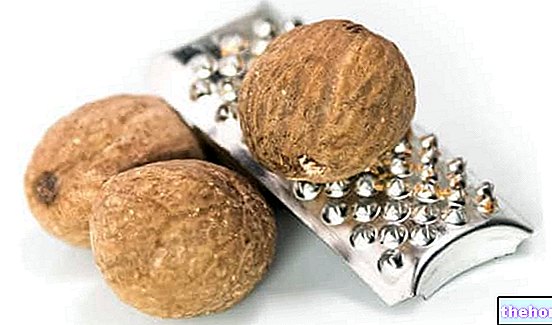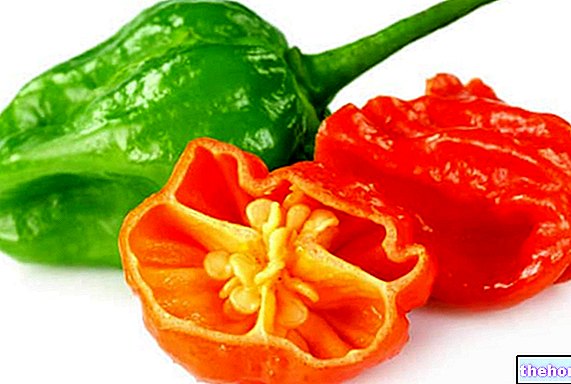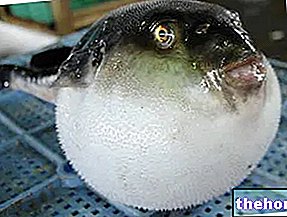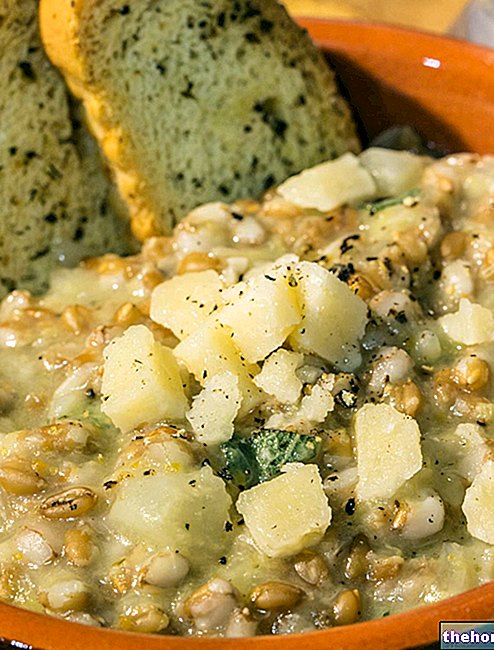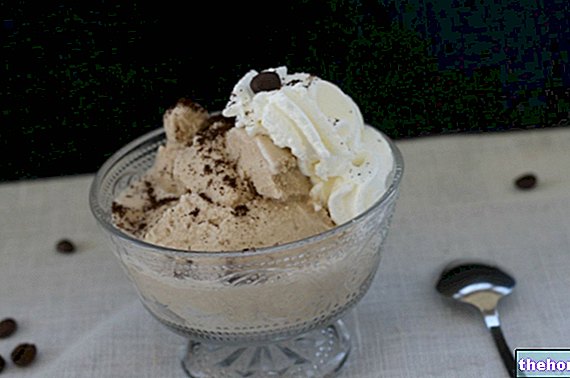Generality
Habanero is a variety of chilli (Capsicum chinense Jacq.).
The term "habanero" is used above all to indicate the fruit of the plant, that is the edible portion.

It is classified as an "exceptionally hot" pepper but, in the Scoville ranking, it does NOT occupy the very first positions; some sources attribute to this pepper 80,000-577,000 SHU, others 100,000-350,000 SHU. In this regard, keep in mind that the extremely hot peppers (Naga Morich, But Jolokia and Trinidad Scorpion) have a spiciness ranging from 1,000,000 to 2,000,000 SHU.
The appearance of the habanero is unripe green, but colored when fully ripe.
The ripest peppers are also the hottest; however, it is not the dyes that give the gustatory effect, but the capsaicinoids (of which, the major exponent is the capsaicin).
The habanero is often compared to the Scotch Bonnet pepper which, in addition to belonging to the same species, has very similar organoleptic characteristics.
Like the other peppers, the habanero also concentrates the spicy molecules especially in the placenta (ie the inner white film); the concentrations in the seeds are also good.
The habanero is a heterogeneous, irregular cultivar, which also offers very different fruits. The factors that generally affect the spiciness of chillies are: genetic heritage, soil and state of ripeness. On the other hand, the same habanero plant is able to ripen various fruits. characterized by a highly variable concentration of capsaicinoids.
The habanero plant is a small shrub (40-80cm tall). It has green leaves and produces small flowers with white petals (from which the fruits will evolve).
Ripe chilli can be of various colors: red, orange, white, brown, yellow and pink; it reaches a size of 2-6cm in length and has a typical lantern shape.
Nutritional Characteristics
The fruit of the habanero is a product of vegetable origin that falls into both the VI and VII food groups.
It has a very low caloric concentration, in which carbohydrates mainly participate. Lipids and proteins are almost irrelevant.
Habanero is an excellent source of vitamin C (ascorbic acid); however, to maintain the concentration of this vitamin, it must be eaten raw or undercooked.
It also provides excellent levels of beta-carotene, lycopene and other carotenoids (provitamins A). These molecules perform important and essential functions for the organism; in fact, together with other NON-vitamin nutritional factors (flavonoids, phenolic acids, chlorophyll derivatives, etc.), they synergistically participate in the fight against oxidative stress imposed by free radicals.
To improve the absorption of carotenoids, which we remember are fat-soluble vitamins in a mainly hydrophilic food, it is good practice to season the food with a drizzle of extra virgin olive oil. This recommendation is very important, especially in the diet of subjects who have undergone a "removal of the gallbladder (due to lack of bile).
Habanero, like all peppers and chillies, is not a particularly digestible food. This aspect is attributable to the toughness of the peel, which is not particularly affected by human digestive juices. The only way to reduce this problem is cooking; moreover, by cooking the chilli, it is also possible to peel it, eliminating the indigestible portion.
Habanero brings a good amount of water, fiber and potassium. However, the typical spiciness prevents its consumption for most subjects.
The habanero is not a product that lends itself to the collective diet. Although it contains vitamins, mineral salts and antioxidants, due to the massive presence of capsaicinoids, it should be excluded in the presence of diseases such as: gastritis, ulcer (gastric and duodenal), gastroesophageal reflux, irritable colon, anal fissures, haemorrhoidal disease, etc. It is also to be avoided for pregnant women and nurses.
Assuming tolerance to spicy taste, the average portion of habanero "could" be 150-300g.

Usage
The habanero pepper originates from the Amazon region (South America). From there, it spread north through Colombia, the Caribbean and into Mexico.
Traces of habanero cultivation have been found in some Peruvian excavations that have unearthed archaeological finds dating back to 6,500 BC.
At the time of its discovery (15th-16th century), the Spanish invaders exported it to other areas characterized by a very similar climate. No wonder eighteenth-century taxonomists confused it for a Chinese plant, hence the name of Capsicum chinense (Chinese pepper).
Today, the world's largest producer is the Mexican Yucatan Peninsula. Here, habanero is an integral part of local food, where it accompanies and season most traditional recipes (whole, cooked, raw in puree, in sauce, etc.).
Other modern producers include: Belize, Panama, Costa Rica, Colombia, Ecuador and parts of the United States including Texas, Idaho and California.
Mexico is the largest consumer of habanero. Today, the habanero has gained popularity all over the world.
Culinary Aspects
The flavor of habanero is fruity, with hints of citrus and a typically floral aroma. Thanks to these characteristics, it is considered the most suitable pepper for the packaging of spicy sauces and condiments.
In Italy, in addition to being an ingredient for salads, for the sauces of first courses and for the seasoning of meats (for example roasts in the oven), it is used in some particular recipes. Among these, some very popular are: fried habanero stuffed with robiola cheese with chives; habanero alla Neapolitan (grilled, peeled, scraped inside and seasoned with salt, oil and raw garlic) etc.
Hints of Cultivation
Habanero is a pepper cultivar that requires high temperatures and tends to be activated in the hot season.
All peppers bear fruit in the summer period, but some of them have a greater tolerance to colder temperatures (for example certain varieties of the Specie frutescens And pubescens).

The habanero grows very well in areas characterized by a good morning sun and a soil with a slightly acid pH (around 5-6). Watering should be done only with well dry soil; the stagnant water tends to cause the roots to rot and, when the plant survives, it produces fruits with a bitter taste.
The habanero is a potentially perennial shrub. Proper care and optimal growing conditions (tropical or sub tropical climate) can guarantee survival and fruiting for many years. However, in temperate climates, it acquires an annual cycle.
Habanero bushes are suitable for growing in pots.
Other Foods - Spices Garlic Dill Cinnamon Cren Curry Daikon Broth Cube Tarragon Monosodium Glutamate Mace Nutmeg Oregano Paprika Black Pepper Green Pepper Pepper Cayenne Pepper Chilli Pepper Parsley Horseradish Rosemary Dietary Salt Whole Salt Iodized Salt Hyposodic Salt Salt Pink Himalayan Salt Mustard Tabasco Vanilla Wasabi Ginger OTHER ITEMS SPICES Categories Food Alcoholics Meat Cereals and derivatives Sweeteners Sweets Offal Fruit Dried fruit Milk and derivatives Legumes Oils and fats Fish and fishery products Salami Spices Vegetables Health recipes Appetizers Bread, Pizza and Brioche First courses Second courses Vegetables and Salads Sweets and Desserts Ice creams and sorbets Syrups, liqueurs and grappas Basic Preparations ---- In the Kitchen with Leftovers Carnival Recipes Christmas Recipes Dietary Recipes Light Recipes Woman's Day, Mother's Day, Dad's Day Functional Recipes International Recipes Easter Recipes Recipes for Celiacs Recipes for Diabetics Recipes for the Holidays Recipes for Valentine's Day Vegetarian Recipes Protein Recipes Regional Recipes Vegan Recipes


